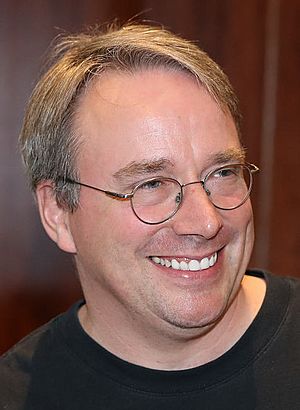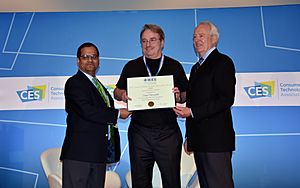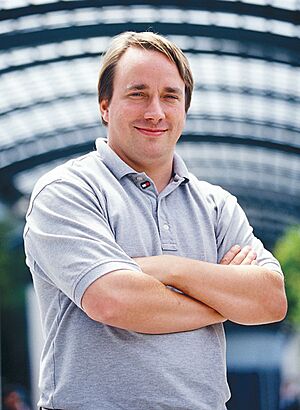Linus Torvalds facts for kids
Quick facts for kids
Linus Torvalds
|
|
|---|---|

Linus Torvalds in 2018
|
|
| Born |
Linus Benedict Torvalds
28 December 1969 Helsinki, Finland
|
| Nationality |
|
| Alma mater | University of Helsinki (M.S.) |
| Occupation | Software engineer |
| Employer | Linux Foundation |
| Known for | Linux, Git |
| Spouse(s) | Tove Torvalds |
| Children | 3 |
| Parent(s) | Nils Torvalds (father) Anna "Mikke" Torvalds (née Törnqvist, mother) |
| Relatives | Sara Torvalds (sister) Leo Törnqvist (grandfather) Ole Torvalds (grandfather) |
Linus Benedict Torvalds is a Finnish software engineer. He is famous for creating the Linux kernel, which is the core part of the Linux operating system. He also created Git, a system used by many developers to manage their computer code.
Linus Torvalds received the 2012 Millennium Technology Prize for creating Linux. This award is sometimes called technology's Nobel Prize. He also won the 2014 IEEE Computer Society Computer Pioneer Award and the 2018 IEEE Masaru Ibuka Consumer Electronics Award.
Contents
Linus Torvalds: His Life and Work
Early Life and Computer Adventures
Linus Torvalds was born in Helsinki, Finland, on December 28, 1969. His parents were journalists. He was named after Linus Pauling, a famous chemist. He also joked that he was partly named after Linus van Pelt from the Peanuts cartoon.
His interest in computers started when he was 11 years old in 1981. He had a VIC-20 computer. He learned to program in BASIC and then directly in machine code. Later, he bought a Sinclair QL computer. He changed its operating system a lot. Because it was hard to find software in Finland, he wrote his own programs. These included an assembler, a text editor, and some games. He even made his own version of Pac-Man called Cool Man.
Linus went to the University of Helsinki from 1988 to 1996. He earned a master's degree in computer science. During his studies, he served in the Finnish Navy. He was an officer for 11 months.
In 1990, he went back to university. There, he first learned about Unix, a powerful computer operating system. He also read a book about MINIX, a simpler version of Unix. This book inspired him. In 1991, he bought a new computer. This allowed him to start working on what would become Linux.
Creating the Linux Operating System
Linus Torvalds first shared his Linux project with the public in late 1991. He put it on an FTP server at his university. The first official version, Linux 1.0, came out on March 14, 1994.
In 1991, Linus learned about the GNU Project. This project promotes "free software." Because of this, Linus changed the license for his Linux kernel. He made it GNU General Public License version 2 (GPLv2). This meant anyone could use, change, and share Linux freely.
After finishing university, Linus moved to California in 1997. He worked for a company called Transmeta. In 2003, he joined the Open Source Development Labs. This organization later became the Linux Foundation. He still works there today, focusing on improving Linux. In 2004, he and his family moved to Oregon.
In 1999, Linus was recognized as one of the top 100 innovators under age 35. Some companies that developed Linux software gave him stock options. When these companies went public, Linus's share value briefly became very high.
Linus's personal mascot is a penguin named Tux. This penguin has become the well-known mascot for the Linux kernel.
Linus believes that "open source is the only right way to do software." Open source means the computer code is available for everyone to see and change. He uses the best tools for his work, even if they are not open source. He once used a program called BitKeeper for managing code. Later, he created his own free and open-source replacement for it, which he named Git.
Linus has used different versions of Linux over the years. He once switched from GNOME to Xfce because he found GNOME difficult to use. But he later returned to GNOME when it improved.
The Linux Foundation supports Linus so he can work full-time on Linux. Linus is known for being very direct when discussing technical issues with other developers. He has apologized for his past behavior, saying it was "unprofessional." He took some time off to learn how to better understand people's feelings. He returned to maintaining the Linux kernel in October 2018.
How Linux Got Its Name
Linus Torvalds originally wanted to call his kernel Freax. This name was a mix of "free," "freak," and "X" (to show it was like Unix). However, his friend Ari Lemmke managed the server where Linus first put the kernel. Ari named Linus's directory linux. This name stuck.
Linus's Role and Other Projects
Linus Torvalds still has the main authority over the Linux kernel. He decides which new code is added to it. Even though thousands of people contribute, his role is very important. He holds the Linux trademark and helps manage its use.
Git: A Tool for Developers
Linus started developing Git on April 3, 2005. Git is a software tool that helps many people work on the same computer code at once. It became very popular. On July 26, 2005, Linus handed over the maintenance of Git to Junio Hamano.
Subsurface: For Scuba Divers
Linus also created a software called Subsurface. He started working on it in late 2011. Subsurface helps scuba divers plan and record their dives. It is also free and open-source software.
Linus's Personal Life
Linus Torvalds is married to Tove Torvalds. She is a six-time Finnish national karate champion. They met in 1993 when Linus was teaching a computer class. Tove sent him an email asking for a date. They have three daughters.
Linus describes himself as an atheist, meaning he does not believe in a god. He feels that appreciating nature and having morals do not need religion.
In 2004, Linus and his family moved from Silicon Valley to Portland, Oregon. In 2010, he became a United States citizen.
Linus developed an interest in scuba diving in the early 2000s. His passion for diving led him to create the Subsurface software.
Awards and Achievements

| Year | Award | Notes |
|---|---|---|
| 2019 | Great Immigrants Award | The Carnegie Corporation of New York honored Torvalds. |
| 2018 | IEEE Masaru Ibuka Consumer Electronics Award | This award is for great contributions to consumer electronics. Linus received it for his leadership in developing and spreading Linux. |
| 2014 | IEEE Computer Pioneer Award | This award recognizes people whose work helped create and grow the computer industry. |
| 2012 | Internet Hall of Fame | Linus was one of the first people to be included in the Internet Hall of Fame. This honors those who have made important contributions to the internet. |
| 2012 | Millennium Technology Prize | Linus was one of two winners of this major technology award. It is often called technology's Nobel Prize. |
| 2010 | C&C Prize | He received this award for his contributions to information technology and improving lives. |
| 2008 | Hall of Fellows | He was honored by the Computer History Museum for creating the Linux kernel. |
| 2005 | Vollum Award | Linus received the Vollum Award from Reed College. |
| 2003 | Linus (Moon) | A small moon of an asteroid was named Linus. This was partly to honor Linus Torvalds. |
| 2001 | Takeda Award | He shared this award with Richard Stallman and Ken Sakamura. |
| 2000 | Lovelace Medal | He received this medal from the British Computer Society. |
| 1998 | EFF Pioneer Award | Linus received an EFF Pioneer Award. |
| 1997 | Academic Honors | Linus earned his master's degree from the University of Helsinki. He later received honorary doctorates from Stockholm University and his own university. The University of Helsinki named an auditorium after him. |
| 1996 | 9793 Torvalds (Asteroid) | An asteroid was named 9793 Torvalds after him. |
Media Recognition
Time magazine has recognized Linus Torvalds several times:
- In 2000, he was ranked 17th in their poll of the most important people of the century.
- In 2004, Time magazine named him one of the most influential people in the world.
- In 2006, Time magazine's Europe edition called him one of the revolutionary heroes of the past 60 years.
InfoWorld gave him an award for Industry Achievement in 2000. In 2005, BusinessWeek listed him as one of "the best managers." In 2004, Finnish TV viewers voted Linus 16th in a poll of the "100 Greatest Finns." In 2010, he was listed among "The 100 Most Influential Inventors of All Time."
In 2017, a Linux company called SUSE released a song about the origin of the Linux kernel, titled "Linus Said."
See also
 In Spanish: Linus Torvalds para niños
In Spanish: Linus Torvalds para niños
- Linus's law
- Tanenbaum–Torvalds debate
- List of pioneers in computer science


